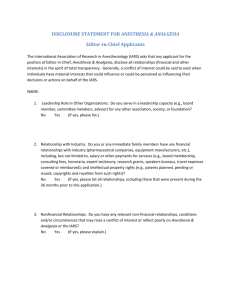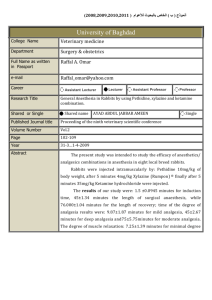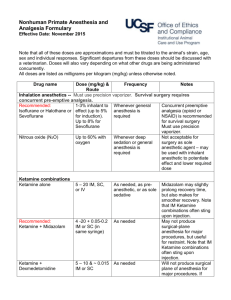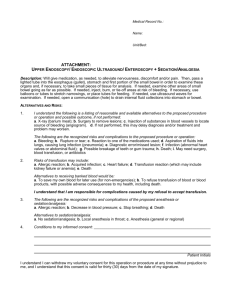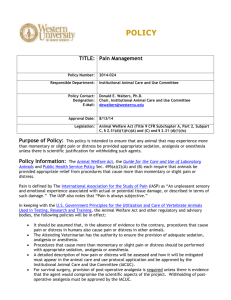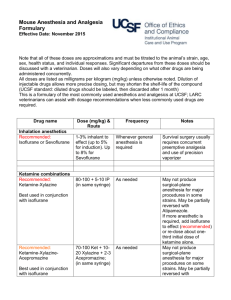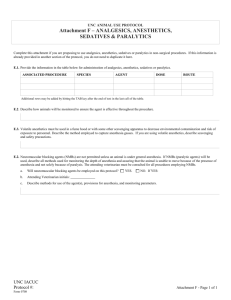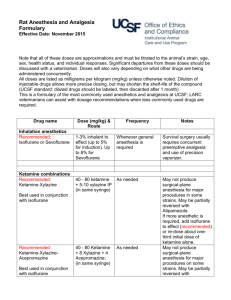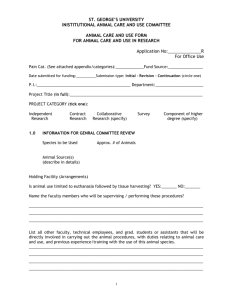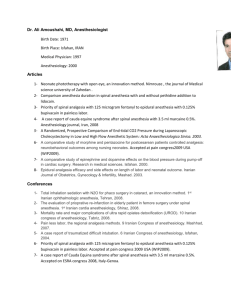Guidelines for Pain/Distress, Anesthesia and Analgesia
advertisement
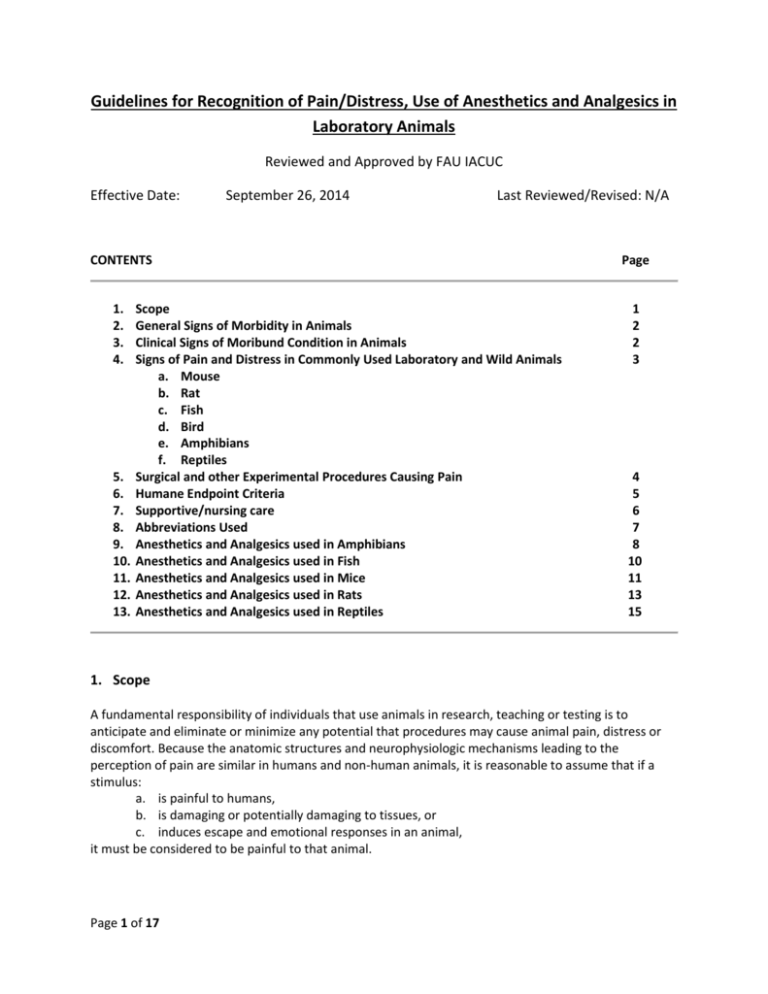
Guidelines for Recognition of Pain/Distress, Use of Anesthetics and Analgesics in Laboratory Animals Reviewed and Approved by FAU IACUC Effective Date: September 26, 2014 Last Reviewed/Revised: N/A CONTENTS Page 1. 2. 3. 4. 1 2 2 3 5. 6. 7. 8. 9. 10. 11. 12. 13. Scope General Signs of Morbidity in Animals Clinical Signs of Moribund Condition in Animals Signs of Pain and Distress in Commonly Used Laboratory and Wild Animals a. Mouse b. Rat c. Fish d. Bird e. Amphibians f. Reptiles Surgical and other Experimental Procedures Causing Pain Humane Endpoint Criteria Supportive/nursing care Abbreviations Used Anesthetics and Analgesics used in Amphibians Anesthetics and Analgesics used in Fish Anesthetics and Analgesics used in Mice Anesthetics and Analgesics used in Rats Anesthetics and Analgesics used in Reptiles 4 5 6 7 8 10 11 13 15 1. Scope A fundamental responsibility of individuals that use animals in research, teaching or testing is to anticipate and eliminate or minimize any potential that procedures may cause animal pain, distress or discomfort. Because the anatomic structures and neurophysiologic mechanisms leading to the perception of pain are similar in humans and non-human animals, it is reasonable to assume that if a stimulus: a. is painful to humans, b. is damaging or potentially damaging to tissues, or c. induces escape and emotional responses in an animal, it must be considered to be painful to that animal. Page 1 of 17 This document is intended to help research personnel during the design and conduct of studies, where potential pain/distress is anticipated with a specific experimental procedure, recognizing signs of pain, finding the appropriate humane endpoints relevant for a particular study and choosing the right anesthetic and/or analgesic regimen for their study animals. Please note that none of the tables/lists is exhaustive but rather include the most common examples. 2. General Signs of Morbidity in Animals These signs can be regularly observed across different species. A single sign or any variation of several of the listed signs might be expressed by the sick animal. Some of the signs are more pronounced in one species compared to another. Please see also “signs of pain and distress in laboratory animal species” below. Many of the animal species used in research are prey species and will hide their signs of morbidity often associated with pain/distress as long as possible making it difficult to detect by an unexperienced person. Therefore, training is necessary to be able to notice subtle signs. As earlier as signs of morbidity and pain/distress are detected as more likely is successful treatment and preservation of the animal as a study subject. a. b. c. d. e. f. g. h. i. Hunched posture Sunken eyes, with or without discharge Rapid weight loss (more than 10% of baseline weight within a couple of days) Decreased body condition score (2.5 or less on a scale of 1-5) Inappetance (decreased or no food intake) Hypothermia or hyperthermia Changes in respiratory rate (decreased vs. increased) or respiratory pattern (e.g. labored) Decreased fecal and/or urinary output; diarrhea; straining during voiding Changed gait such as unsteady ataxic movements or lameness not induced by experimental manipulations j. Ulcerated tumors k. Ulcerative or other severe dermatitis 3. Clinical Signs of Moribund Condition in Animals The following list is again not exhaustive and usually includes varying signs of morbidity listed above but often with a higher degree of severity. Not all signs have to be present at the same time. a. Impaired mobility with inability to retrieve food and water b. Inability to keep upright (loss of righting reflex) c. Labored breathing and cyanosis (blue color of mucous membranes and normally light pink skin) d. Moderate to severe dehydration (tenting of skin, sunken eyes) e. Severe, rapid weight loss and emaciation (≥20% of baseline body weight) f. Signs of lethargy and lack of physical activity g. Self-mutilation h. No response to external stimuli Page 2 of 17 4. Signs of Pain and Distress in Laboratory Animal Species Species/ Taxa MOUSE RAT FISH BIRDS AMPHIBIANS REPTILES Signs of mild to moderate pain/distress Eyelids partially closed; changes in respiration; rough hair coat; increased vibrissae movement; unusually apprehensive or aggressive; possible writhing, scratching, biting, self-mutilation; hunched posture; sudden running; aggressive vocalization; guarding. Eyelids partially closed; porphyrin staining around eyes, nose; rough hair coat ± hair loss; increased aggression; reduced exploratory behavior; aggressive vocalization; licking, biting, scratching; guarding. rapid or labored respirations (gill or mouth movements), color changes, posture and orientation changes, water column utilization, decreased activity, lessened swimming, agitated swimming, activity at bottom of tank consistently, skin changes and growths Increased escape behavior, vocalization when approached or handled, excessive movement, increased head movement Decrease in avoidance behavior (e.g. when approached), abnormal behavior, reduced food/water intake, closed eyes, color changes Absence of normal behavior, changes in posture, color changes (general darkening), lameness, reduced food/water intake, lack of activity, hiding, partial/full retreat – movement away from observer, changed respiration rate and depth Signs of severe or chronic pain/distress Weight loss; dehydration; incontinence; soiled hair coat; eyes sunken, lids closed; wasting of muscles on back; sunken or distended abdomen; decreased vibrissae movement; unresponsive; separates from group; hunched posture; ataxia; circling; hypothermia; decreased vocalization. Eyes closed; poor skin tone; muscle wasting along back; dehydration; weight loss; incontinence; soiled hair coat; depressed/ unresponsive; sunken or distended abdomen; self-mutilation; recumbent position with head tucked into abdomen; decreased vocalization; hypothermia. strong reflexive responses such as muscular and behavioral avoidance, secretion accumulation around eyes, mouth, gills, frayed fins and gill discoloration, changes in body condition such as emaciation or changed body curvature Eyelids partially closed; anorexia; ruffled, drooping, unkempt appearance; immobility when approached; crouched posture; head drawn toward body; reduced perching Movement aversion, lethargy, closed eyes, anorexia, color changes, flicking with extremities or biting of affected area, lameness and ataxia, accelerated breathing Increased aggression with manual manipulation, rubbing/biting affected body part, skin color changes, head extended away from body (esp. chelonians), non-weight baring lameness, no food/water intake, dehydration, complete reluctance to move, oblivious to environment, hiding, lethargy Note: Signs can vary with species (e.g. hunched posture not possible in chelonians) and individuals within a species, to detect abnormal behavior the observer has to be familiar with the normal behavior of the particular species Page 3 of 17 5. Surgical and other Experimental Procedures Causing Pain Certain procedures are always assumed to cause or have the potential to cause pain or distress. It is generally understood that vertebrate animals including species of the taxa mammals, birds, amphibians, reptiles and fish are capable of perceiving pain due to similar pain pathways as in humans. Although it is accepted for mammals questions still persist such as do fish, amphibians and reptiles feel pain. Can we recognize this pain? Is the perception of pain by these species equivalent to that of a mammal? These questions might never be fully answered because animals cannot tell us. However, the inability to communicate should not dictate whether pain is being perceived or whether an analgesic drug should be administered. The U.S. Government Principles for the Utilization and Care of Vertebrate Animals Used in Testing, Research and Training state that in general, unless the contrary is known or established, it should be considered that procedures that cause pain in humans may also cause pain in other animal (IRAC 1985). A. Procedures capable to induce pain and/or distress a. Surgery b. Studies that require the animal to reach a moribund state or die spontaneously as the endpoint of the study c. Prolonged physical restraint d. Malignant neoplasms e. Prolonged food or water deprivation f. Distal tail biopsy in animals over 3 weeks of age (tail snipping) g. Electrical shock or other adverse stimuli that are not immediately escapable h. Paralysis or immobility in a conscious animal i. Inflammatory disease j. Organ failure resulting in clinical signs k. Non-healing skin lesions l. Whole body irradiation at high doses m. Repeated use of, large volumes of, or intradermal injections of Freund’s complete adjuvant n. Intraperitoneal implantation of ascites-producing hybridomas for monoclonal antibody production B. Examples for survival procedures causing MARKED post-procedural pain a. Thoracotomy b. Laparotomy or celiotomy c. Transplantation of organs d. Extensive orthopedic surgeries and limb amputations C. Examples for Survival procedures causing MODERATE post-procedural pain a. Laparoscopy b. Craniotomy c. Limited orthopedic surgery D. Examples for Survival procedures causing MILD post-procedural pain a. Implantation of subcutaneous mini pumps b. Implantation of subcutaneous tumors or resection of subcutaneous tumors c. Placement of chronic indwelling vascular catheters Page 4 of 17 6. Humane Endpoint Criteria A humane endpoint is the IACUC approved earliest scientifically justified point at which pain and/or distress in an animal used in a research model can be prevented, terminated, or relieved, while meeting the scientific aims and objectives of the study. Humane endpoints refer to one or more predetermined physiological or behavioral signs when presented by an animal will require an action to either terminate or reduce/minimize perceived pain and/or distress. Those actions include euthanasia, termination of the painful/distressful procedure or providing treatment to relieve pain/distress (see also CCAC Guidelines at http://www.ccac.ca/Documents/Standards/Guidelines/Appropriate_endpoint.pdf ). Humane endpoints function as an alternative to experimental endpoints and can serve as a refinement of the research. It is important to establish humane endpoint prior to start of the study to prevent unnecessary pain/distress while still ensuring accurate and timely data collection. To be meaningful, humane endpoints must be clearly defined and based on objective criteria. To be able to select endpoints that are both humane and scientifically sound, it requires the investigator to be familiar with the particular animal model. Endpoints can be refined and modified at any time, especially as experience with and data collection from an animal model increases. Sometimes Pilot Studies can be useful in determining endpoints, especially if the outcome of an experimental treatment in animals is not well known. Investigators should include the following in their IACUC protocol when describing humane endpoints: A precise definition of the humane endpoint(s), including specific assessment criteria. Please refer to examples provided in this document. The frequency of animal observation and evaluation. The action(s) taken when an animal reaches the described humane endpoint(s). The training and experience of personnel responsible for observation and evaluation. Humane endpoints must be objective and relevant to the particular animal model. Appropriate endpoints may include: Body weight changes External physical appearance Behavioral changes Physiological changes such as body temperature, hematology, hormonal fluctuations etc. Examples of humane endpoints: Deteriorating body condition score o Objective and easy to use o Especially useful in experiments where some degree of debilitation expected o Scoring methods for many species available in scientific literature Weight loss o Base weight assessment necessary o Either rapid weight loss (i.e. few days 15-20%) or gradual weight loss to emaciation o Might be masked by other conditions (e.g. weight gain due to tumor growth) Inability to rise or ambulate o Correlates with inability to retrieve food and water Presence of labored breathing o Animal shows increased respiratory rate and/or effort. Dehydration Page 5 of 17 7. Supportive/Nursing Care Pain/distress management is multifaceted and not only reduced to drug management with anesthetics, analgesics, tranquilizers and/or anxiolytics. It is important to provide an animal in pain/distress with a stress-free and non-irritating environment whenever possible. The following supportive/nursing care measures should always be implemented, especially after surgical and any other experimental painful/distressful procedures. It can be either combined with analgesics or without any drug administration depending on the study and approval by the IACUC. Also here, the chosen methods depend on the species and species-specific behavior should be respected. Clean primary enclosure (e.g. cage, run, pen) Quiet environment (away from noisy animals or human activity) Optimal light intensity o Dimmed light o Hiding spaces in primary enclosure for animal to be able control light intensity Adequate temperature o Increased room temperature o Enclosure specific possibilities for improved thermoregulation (i.e. nesting material for mice) o Cages half on – half off heating pads to allow animal control over temperature o Thermal insulation (i.e. bedding/substrate rather than laying on a cold surface) Appropriate humidity Keep well hydrated o warmed subcutaneous, intravenous, intraosseous or intraperitoneal fluids o palatable fluids o provide fluid with different taste a couple of days before painful insult in neophobic animals (e.g. rats) Nutritional support o Easily accessible food (e.g. not having to stretch after laparotomy – on bottom of cage) o Easily digestible/palatable food o Easily consumable (e.g. mashed food instead of hard pellets) o High caloric paste-type diets Provide hiding spaces o Tunnels o Igloos, shacks Social housing of social animals whenever possible Timely wound and bandage management as applicable o As described in IACUC protocol Management of post-operative infections o note: antibiotics are not to be substituted for aseptic technique o contact veterinarian if signs of infection observed Page 6 of 17 8. Abbreviations Used BW CRI IM IP PO q SC Page 7 of 17 body weight constant rate infusion intramuscular intraperitoneal per os (i.e. oral) every subcutaneous 9. Anesthetics and Analgesics used in Amphibians Anesthesia in Amphibians Dose & Route Comments Isoflurane To effect. Inhalation in anesthetic chamber. In general, 5% induction and 2-3% maintenance Mixture of 3ml isoflurane, 3.5ml KY jelly and 1.5 ml water - topical Bubbled into water to effect 50-200mg/kg intracoelomic For terrestrial species Adequate ventilation or scavenging essential Bufo spp (0.035 ml/g BW), African Clawed Frogs (0.025 ml/g BW) Aquatic species Wide range depending on Species Frogs/salamander Leopard frogs Bullfrogs Tricaine methane sulfonate – MS222 0.5-2 g/L water bath to effect 100-200 mg/kg intracoelomic 100-400mg/L intracoelomic Ketamine 50-150 mg/kg SC, IM May have long induction/recovery time, no good analgesia provided Lidocaine 1% to 2% 50-150 mg/kg SC, IM, local infiltration Dilute 3:1with sodium bicarbonate Bupivacaine <2 mg/kg Lidocaine-Bupivacaine mixture < 2 mg/kg EMLA cream Thick spread – topical application Duration 30-60 min; with/without epinephrine; with Ketamine for minor surgeries; use with caution Duration 3-4 hours, slow onset Same comment as for Lidocaine Duration 1 -4 hours Same comments as for Lidocaine Combination of both drugs allows for rapid onset and prolonged effect 30-60 min Apply thick layer ideally 10 min before painful procedure Local Anesthesia/Analgesia Analgesia in Amphibians Buprenorphine 38-75 mg/kg; inject into dorsal lymph sac Duration > 4hours Carprofen 2-4 mg/kg PO, SC, IM Followed by 1-2 mg/kg q24-72 hours Codeine 53 mg/kg SC In leopard frogs Page 8 of 17 Analgesia in Amphibians Dose & Route Comments Fentanyl 05. mg/kg Duration > 4hours, in leopard frogs Meloxicam 0.1 – 1.0 mg/kg PO, SC, Intracoelomic Provide every 24 hours Morphine 38-42 mg/kg SC Duration > 4hours Notes: 1. Amphibians must be kept moist over their entire bodies during anesthesia and recovery. Animals must be observed during immersion induction to ensure that they do not become totally immersed, as this will result in drowning. 2. MS222 is acidic in solution and causes acid stress in amphibians. Sodium bicarbonate is commonly used as buffering agent to adjust to a pH of 6-7. See also Guidelines for MS222 (link) 3. Infiltrate or apply local analgesics to areas where the painful stimulus will be induced. Repeat application of local agent at specified intervals (i.e. depending on expected duration) to maintain analgesia. Do not increase dosage or frequency of application beyond recommendation to avoid toxicity. Page 9 of 17 10. Anesthetics and Analgesics used in Fish Anesthesia in Fish Dose & Route Comments Tricaine Methane Sulfonate = MS222* 15-50mg/L immersion 50-200mg/L immersion 50-100mg/L immersion 1 g/L Spray onto gills directly Benzocaine Hydrochloride 15-40 mg/L immersion 50-100 (up to 500) mg/L immersion 1 g/L spray onto gills directly Sedation Induction Maintenance Large fish when immersion impossible Sedation Small margin of safety between effective and lethal dose Buffer solution with sodium bicarbonate to maintain ideal pH Local Anesthesia/Analgesia Lidocaine – local anesthetic <2 mg/kg Bupivacaine – local anesthetic <2 mg/kg Lidocaine-Bupivacaine mixture < 2 mg/kg Duration 30-60 min, fast onset Because drug is acidic dilute 3:1 with sodium bicarbonate solution (prepare fresh, don’t store), dilution will prolong analgesia slightly Duration 3-4 hours, slow onset Same comment as for Lidocaine Duration 1 -4 hours Same comments as for Lidocaine Combination of both drugs allows for rapid onset and prolonged effect Analgesia in Fish Morphine 10mg/L immersion MS222 10-50 mg/L immersion Buprenorphine 0.4mg/kg IM or SC Single dose prior to recovery from anesthesia Ketoprofen 2mg/kg IM Single dose prior to recovery from anesthesia Notes: 1. MS222 is acidic in solution and causes acid stress in fish. Sodium bicarbonate and sodium hydroxide are both commonly used as buffering agents to adjust to a pH of 6-7. See also Guidelines for MS222 2. Infiltrate or apply local analgesics to areas where the painful stimulus will be induced. Repeat application of local agent at specified intervals (i.e. depending on expected duration) to maintain analgesia. Do not increase dosage or frequency of application beyond recommendation to avoid toxicity. Page 10 of 17 11. Anesthetics and Analgesics used in Mice Anesthesia in Mice Dose & Route Comments Isoflurane (Forane®) Halothane (Fluothane®) Enflurane (Ethrane®) Ketamine + Xylazine To effect. In general, 3-5% induction, 1-3% maintenance; inhalation 90-120 (K) + 7.5- 10 (X) mg/kg IP Precision vaporizer, adequate ventilation or scavenging essential 30 – 45 minute duration; may supplement with ketamine only @ 1/3 -1/2dose Ketamine + Xylazine + Acepromazine 70- 100 (K) + 5-10 (X) + 1-3 (A) mg/kg IP Pentobarbital 30-90 mg/kg IP Tribromoethanol (Avertin) Hypothermia (Neonates <6 days old undergoing minor surgical procedures only) 125-250 mg/kg IP Submerge for 3-4 minutes in ice water Caution! Potentially significant cardiovascular and respiratory depression, variable response Store at 4°C; dark conditions Pup placed in rubber sleeve or other separating material, submerged to cervical area with resultant 10 min of anesthesia Local Anesthesia/Analgesia Lidocaine 1-2% Bupivacaine 0.25-0.5% 1-2 up to 10 mg/kg local infiltration Up to 5 mg/kg local infiltration Fast onset, duration up to 2 hrs Slower onset, duration at least 6 hours Improved performance with fast onset and prolonged duration Lidocaine/Bupivacaine Mixed 1:1 for local infiltration EMLA cream Layer (thick) of topical application May take up to 30min for effect Morphine 1 – 10 mg/kg SC Up to 4 hours of analgesia Codeine 10-20 mg/kg SC Up to 4 hours of analgesia Oxymorphone 0.05-0.15 mg/kg SC Up to 3 hours of analgesia Butorphanol (Torbutrol® 0.5mg/ml) 0.05 – 5.0 mg/kg SC 1 – 2 hours of analgesia Buprenorphine (Buprenex®) 0.05 – 0.1 mg/kg SC 8-12 hours of analgesia Buprenorphine SR (slow release) 0.15-0.36 mg/kg SC Up to 72 hours of analgesia Carprofen 5-10 mg/kg SC From 12 - 24 hours of analgesia Ketoprofen 5-10 mg/kg SC Up to 24 hours of analgesia Aspirin 300 mg/kg PO (drinking water) Per 24 hours Ibuprofen 7.5 mg/kg PO (drinking water) Per 24 hours Acetaminophen 100-300 mg/kg PO (drinking water) Per 24 hours; 6mg/ml water Analgesia in Mice Page 11 of 17 Notes: 1. Normal daily water consumption for mice is 15ml/100g body weight/day 2. Animals that are painful will not drink the “normal” amount of water, especially for the first 24 hours after surgery/painful procedure. It is estimated that the water consumption will be reduced by at least 50%. Therefore, providing analgesic drugs in the drinking water 24hours post-operatively will be in all likelihood not provide sufficient analgesia. 3. Infiltrate or apply local analgesics to areas where the painful stimulus will be induced. Repeat application of local agent at specified intervals (i.e. depending on expected duration) to maintain analgesia. Do not increase dosage or frequency of application beyond recommendation to avoid toxicity. Page 12 of 17 12. Anesthetics and Analgesics used in Rats Anesthesia in Rats Dose & Route Comments Isoflurane (Forane®) To effect. In general, 3-5% induction, 1-3% maintenance; inhalation 60 – 90 (K)+ 6 – 10 mg/kg (X) IP Precision vaporizer, adequate ventilation or scavenging essential 30 – 45 minute duration; may supplement with ketamine only @ 1/3 -1/2dose Ketamine + Xylazine Ketamine + Xylazine + Acepromazine Tiletamine – Zolazepam (Telazol®) 40 (K) + 8-10 (X) + 3-4 (A) mg/kg IP 20 – 40 mg/kg IP Urethane 1000 – 1200 mg/kg IP Inactin Pentobarbital 80 – 100 mg/kg IP 30 – 40 mg/kg IV 40 – 50 mg/kg IP Concentration of reconstituted mixture is 100 mg/ml Caution! Prolonged anesthesia; terminal procedures only; carcinogenic and mutagenic Not Recommended Caution! Potentially significant cardiovascular and respiratory depression, variable response Local Anesthesia/Analgesia Lidocaine 1-2% Bupivacaine 0.25-0.5% 1-2 up to 10 mg/kg local infiltration Up to 5 mg/kg local infiltration Fast onset, duration up to 2 hrs Smilower onset, duration at least 6 hours Improved performance with fast onset and prolonged duration Lidocaine/Bupivacaine Mixed 1:1 for local infiltration EMLA cream Layer (thick) of topical application May take up to 30min for effect Morphine 5-10 mg/kg SC Up to 4 hours of analgesia Codeine 40-50 mg/kg SC Up to 4 hours of analgesia Oxymorphone 0.22-0.33 mg/kg SC 1.2-1.6 mg/kg SC Up to 4 hours of analgesia As a slow release liposome Butorphanol (Torbutrol® 0.5mg/ml) Buprenorpine (Buprenex®) 0.05 – 5.0 mg/kg SC Up to 4 hours of analgesia 0.01 – 0.1 mg/kg SC From 8-12 hours of analgesia 0.5-1.2 mg/kg Up to 72 hours of analgesia 5-10 mg/kg SC Up to 24 hours of analgesia Analgesia in Rats Buprenorphine SR (slow release) Ketoprofen Analgesia in Rats Page 13 of 17 Carprofen 2-5 mg/kg SC Up to 12 hours of analgesia Aspirin 50-100mg/kg PO (drinking water) Per 24 hours Ibuprofen 15-30 mg/kg PO (drinking water) Per 24 hours Acetaminophen 100-300 mg/kg PO (drinking water) Per 24 hours; 6mg/ml water Notes: 1. Normal daily water consumption for rats is 8-11 ml/100g body weight/day 2. Animals that are painful will not drink the “normal” amount of water, especially for the first 24 hours after surgery/painful procedure. It is estimated that the water consumption will be reduced by at least 50%. Therefore, providing analgesic drugs in the drinking water 24hours post-operatively will be in all likelihood not provide sufficient analgesia. 3. Rats are neophobic. This means if they associate the pain with change in taste/look of the water they will not drink it. Therefore, the pain medication in water must be started at least 48 hours before the painful procedure. 4. Infiltrate or apply local analgesics to areas where the painful stimulus will be induced. Repeat application of local agent at specified intervals (i.e. depending on expected duration) to maintain analgesia. Do not increase dosage or frequency of application beyond recommendation to avoid toxicity. 13. Anesthetics and Analgesics used in Reptiles Page 14 of 17 Anesthesia in Reptiles Dose & Route Comments Isoflurane Anesthetic of choice in reptiles Ketamine/Acepromazine 3-5% induction, 1-3% maintenance inhalation 55-88 (K) + 0.05-0.5 (A) mg/kg IM, SC Ketamine/Diazepam 60-80 (K) + 0.2-1 (D) mg/kg IM Ketamine/Butorphanol Ketamine/Midazolam 10-30 (K) + 0.5-1.5 (B) mg/kg IM 20-40 (K) + 1-2 (M) mg/kg IM 60-80 (K) + 1-2 (M) mg/kg IM 0.3-0.5 mg/kg/min IV, IO via CRI or 0.5-1 mg/kg IV, IO periodic bolus Propofol 3-5 mg/kg IV 10 mg/kg IV 20 mg/kg IV Most species/surgical anesthesia induction 30min, recovery 24-96 hours Chelonians surgical anesthesia Chelonians/ minor Sx procedures Chelonians/sedation Chelonians/ Sx anesthesia Most species/maintenance anesthesia; must provide respiratory and thermal support Chelonians/sedation Red eared slider 40-85min Red eared slider 60-120min Local Anesthesia/Analgesia Lidocaine 0.5-2 % 2-5 mg/kg local infiltration or topical Bupivacaine 1-2 mg/kg local infiltration Lidocaine-Bupivacaine mixture < 2 mg/kg EMLA cream – local anesthetic Thick spread Duration 30-60 min, fast onset Because drug is acidic dilute 3:1 with sodium bicarbonate solution (prepare fresh, don’t store), dilution will prolong analgesia slightly Duration 4-12 hours, slow onset 4 mg/kg max dose Duration 1 -4 hours Same comments as for Lidocaine Combination of both drugs allows for rapid onset and prolonged effect 30-60 min Apply thick layer ideally 10 min before painful procedure Analgesia in Reptiles Buprenorphine 0.005-0.02 mg/kg IM Most species, q 24-48 hours Carprofen 1-4 mg/kg PO, SC, IM, IV Followed by 1-2 mg/kg q24-72 hrs., most species Flunixin meglumine 0.5-2 mg/kg IM Most species, q 12-24 hours Ketoprofen 2 mg/kg SC, IM Most species, q 24-48 hrs. 0.1-0.5 mg/kg PO, SC, IM Most species, q 24-48 hrs. Analgesia in Reptiles Meloxicam Page 15 of 17 0.5 mg/kg PO, IM Tramadol 0.1-0.2 mg/kg PO, IM 5-10 mg/kg PO Red eared sliders, better absorption IM vs. PO Chelonians, q24 hrs x 4-10 days Red eared sliders, higher doses might affect ventilation Note: Infiltrate or apply local analgesics to areas where the painful stimulus will be induced. Repeat application of local agent at specified intervals (i.e. depending on expected duration) to maintain analgesia. Do not increase dosage or frequency of application beyond recommendation to avoid toxicity. References: Mader, DR and Divers, SJ. Current Therapy in Reptile Medicine & Surgery. Elsevier Saunders, St. Louis, MI. 2014. Page 16 of 17 Institute for Laboratory Animal Research at http://nas-sites.org/animal-pain/how-to-recognizepain-in-animals Canadian Council on Animal Care. Guidelines on: Choosing an Appropriate Endpoint in Experiments Using Animals for Research, Teaching and Testing at http://www.ccac.ca/Documents/Standards/Guidelines/Appropriate_endpoint.pdf UC Davis Center for Animal Alternatives http://www.lib.ucdavis.edu/dept/animalalternatives/endpoints.php Ullman-Cullere, M. Body condition scoring: a rapid and accurate method for assessing health status of mice. Laboratory Animal Science 1999, 49(3):319-323. Hankenson, FC. Critical Care Management for Laboratory Mice and Rats. CRC Press. Boca Raton, FL. 2014 Page 17 of 17
